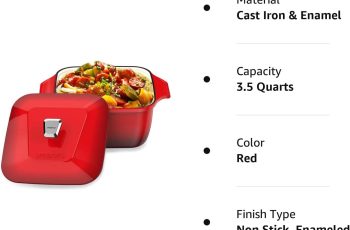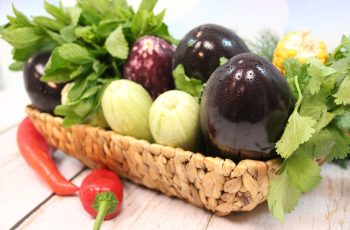Ad Blocker Detected
Our website is made possible by displaying online advertisements to our visitors. Please consider supporting us by disabling your ad blocker.
In the culinary world, the choice of cookware can significantly impact the outcome of a dish. Aluminum saucepans have long been a popular option due to their efficient heat conductivity and affordability. However, it is vital to understand the chemistry behind cooking acids in these saucepans. This article will explore the reactions that occur when acidic ingredients come in contact with aluminum, providing insights into the potential health risks and suggesting alternative options for a safe and delicious cooking experience.
The Chemistry of Aluminum Saucepans
Overview of Aluminum Saucepans
Aluminum saucepans are a popular choice among home cooks and professional chefs alike due to their excellent heat conductivity and affordability. These saucepans are lightweight, making them easy to handle, and they distribute heat evenly, ensuring that food cooks uniformly. However, it is essential to understand the chemistry behind aluminum saucepans, particularly when it comes to cooking with acidic ingredients, to ensure both food quality and your own well-being.
Chemical Properties of Aluminum
Aluminum is a versatile metal with unique chemical properties. It is known for its corrosion resistance, lightweight nature, and high thermal conductivity. Aluminum also forms an oxide layer on its surface, which further enhances its resistance to corrosion. However, this oxide layer can be affected by certain acids, leading to potential chemical reactions and subsequent effects on both the saucepan and the food being prepared.
Effects of Acids on Aluminum
When aluminum comes into contact with acidic ingredients, a chemical reaction can occur. Acids have the potential to remove the protective oxide layer from the aluminum surface, exposing the metal to corrosion. This reaction can lead to the transfer of aluminum ions into the food, affecting its taste, color, and texture. Moreover, prolonged exposure to acidic ingredients can cause pitting and discoloration on the surface of the saucepan, compromising its durability and aesthetic appeal.
Importance of Understanding the Chemistry
Understanding the chemistry behind aluminum saucepans is vital for several reasons. Firstly, it allows you to make informed decisions about the type of saucepan you choose for specific cooking tasks. Secondly, it enables you to modify your cooking techniques and ingredient choices to minimize the potential negative effects of acids on both the saucepan and the food. Finally, being aware of these chemical interactions helps maintain food quality and ensures the safe usage of aluminum saucepans, promoting a healthy cooking environment.
Acids in Cooking
Types of Acids Used in Cooking
Cooking often involves using acids to enhance flavors, tenderize meat, or assist in various chemical reactions. Some common cooking acids include lemon juice, vinegar, tomato juice, and buttermilk. Each of these acids has its own unique properties, flavors, and effects on food.
Role of Acids in Cooking
Acids play a pivotal role in cooking by imparting a tangy or sour taste to dishes. They can also act as natural preservatives, inhibit enzymatic browning, and help retain the vibrant colors of certain fruits and vegetables. Furthermore, acids can tenderize tough cuts of meat by breaking down connective tissues, resulting in more tender and flavorful dishes.
Chemical Reactions with Acids
When acids interact with other ingredients during cooking, various chemical reactions take place. One significant reaction is acid-base neutralization, wherein acids react with alkaline ingredients such as baking soda or certain spices. This reaction forms carbon dioxide gas, leading to the leavening of baked goods. Acids can also cause proteins to denature, resulting in coagulation and the thickening of certain sauces and custards.
Impact of Acids on Flavor and Texture
The presence of acids in cooking can greatly impact the flavor and texture of the final dish. Acids can enhance the brightness and freshness of flavors, adding a pleasant tanginess to dishes. Additionally, acids can help create more tender and moist textures in foods, particularly when used in marinades or dressings. However, it is crucial to consider the interaction of acids with aluminum saucepans to avoid any undesirable effects on the quality of both the food and the cookware.
Interactions Between Acids and Aluminum Saucepans
Acidic Foods and Aluminum
Cooking with acidic foods in aluminum saucepans can lead to chemical reactions and potential negative effects on both the saucepan and the food. Acidic foods, such as citrus fruits, tomatoes, and vinegar, contain compounds that can react with the aluminum surface, compromising its integrity and potentially altering the taste and appearance of the food being prepared.
Corrosion of Aluminum in Acidic Environment
When aluminum is exposed to an acidic environment, such as lemon juice or tomato sauce, the acid can penetrate the protective oxide layer on the aluminum surface. This leads to the corrosion of the metal, resulting in pitting, discoloration, and the release of aluminum ions into the food. Corrosion can happen more rapidly if the saucepan is damaged or has scratches on its surface, as it provides easier access for acids to interact with the aluminum.
Release of Aluminum Ions
The corrosion of aluminum in the presence of acids can lead to the release of aluminum ions into the food being cooked. These ions can affect the taste and color of the food, potentially leaving a metallic or bitter aftertaste. Moreover, continuous exposure to aluminum ions through consumption can raise concerns about potential health risks, especially for individuals with certain medical conditions or sensitivities.
Effects on Food Quality
The interaction between acids and aluminum saucepans can have detrimental effects on the quality of the food being prepared. The flavor profile of the dish may be altered, with acidic ingredients becoming more metallic or bitter in taste. Colors may also change, resulting in a less appetizing appearance. Additionally, the texture of the food can be affected, leading to undesirable results such as a mushy or disintegrated consistency.
Health Concerns
Aluminum in Food
While aluminum is naturally present in the environment, including in food and water, excessive intake of this metal can raise concerns about potential health risks. Aluminum is a neurotoxin and has been linked to neurological disorders such as Alzheimer’s disease. Therefore, it is crucial to manage the exposure to aluminum, including through the use of aluminum saucepans in cooking.
Potential Health Risks
The release of aluminum ions into food prepared in aluminum saucepans may contribute to the overall aluminum intake in the diet. While the direct link between aluminum intake and health issues is still under investigation, it is important to minimize the potential risk by adopting safe cooking practices and being mindful of the interaction between acids and aluminum.
Safe Usage of Aluminum Saucepans
To ensure the safe usage of aluminum saucepans, it is advisable to employ preventive measures and responsible cooking techniques. By understanding the chemistry behind aluminum saucepans and the potential effects of acids, you can make informed decisions about recipe modifications and ingredient choices. Additionally, proper cleaning and maintenance of aluminum saucepans can help reduce the risk of aluminum ions being released into food during cooking.
Preventing Acidic Reactions with Aluminum Saucepans
Using Non-Acidic Ingredients
One effective way to prevent acidic reactions with aluminum saucepans is to use non-acidic ingredients or minimize the use of highly acidic ones. Choosing ingredients with a neutral pH, such as water, chicken broth, or vegetable stock, can reduce the risk of corrosion and the release of aluminum ions into the food.
Coating or Seasoning Aluminum Saucepans
Another method to protect aluminum saucepans from acidic reactions is to coat or season them. Seasoning involves applying a thin layer of oil or fat to the surface of the saucepan, creating a barrier between the aluminum and the acidic ingredients. Coating the saucepan with an enamel or non-stick material can also prevent direct contact between the acidic ingredients and the aluminum, ensuring the integrity of both the saucepan and the food.
Avoiding Prolonged Cooking with Acids
Minimizing the amount of time acidic ingredients spend in contact with aluminum saucepans can significantly reduce the risk of adverse reactions. If possible, cook acidic ingredients separately and add them to the saucepan toward the end of the cooking process. This allows for the desired flavor to be imparted without prolonged exposure to the aluminum surface.
Proper Cleaning and Maintenance
Proper cleaning and maintenance of aluminum saucepans are essential to ensure their longevity and minimize the risk of acidic reactions. Avoid using abrasive cleaners or utensils that can scratch the surface of the saucepan, as these scratches can provide easy access for acids to react with the aluminum. Instead, opt for gentle cleaning techniques using mild dish soap and non-abrasive sponges.
In conclusion, understanding the chemistry of aluminum saucepans and the effects of acids on both the cookware and the food being prepared is crucial for safe and high-quality cooking. By being aware of the potential interactions, you can make informed decisions regarding ingredient choices, cooking techniques, and proper maintenance to ensure a healthy and enjoyable culinary experience. Remember to implement preventive measures such as using non-acidic ingredients, coating or seasoning saucepans, avoiding prolonged exposure to acids, and practicing proper cleaning and maintenance techniques to safeguard your health and preserve the integrity of your aluminum saucepans.

